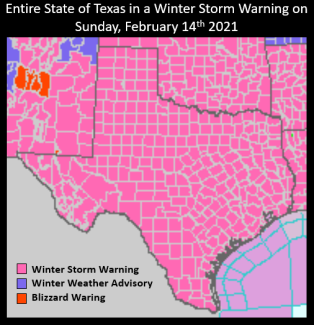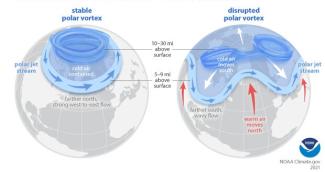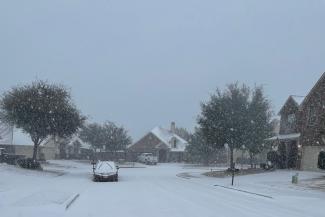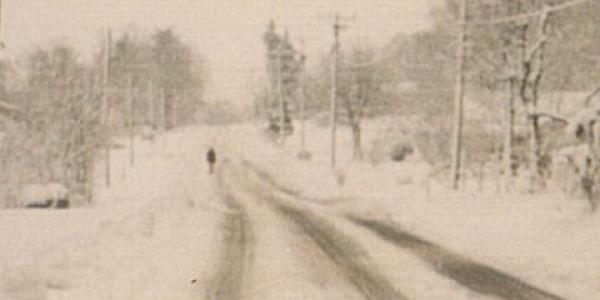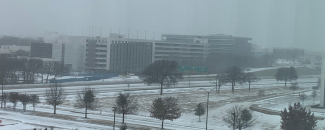
On February 11-20, 2021, a historical winter event occurred that set many records, including being the first billion-dollar weather disaster of that year. A deep freeze impacted parts of the continental United States (CONUS), remarkably engulfing the entire state of Texas. Every county in the state as far south as the Rio Grande River and northeastern Mexico was placed under a Winter Storm Warning, with many experiencing wind chill values below zero. It was the coldest winter storm for Texas since December 1989.
Meteorology
A multitude of factors contributed to the brutal and enduring cold that enveloped the entire state of Texas. One notable factor was the strongly negative Arctic Oscillation (AO), a back-and-forth shifting of atmospheric pressure between the Arctic and the mid-latitudes of the north Pacific and north Atlantic. The AO influences weather and climate in North America, Europe, and Asia, making the most impact during the winter season. A strongly positive AO can influence the powerful mid-latitude jet stream to move storms northward, reducing cold air blasts in the mid-latitude regions. With a negative AO, a weaker jet can dip further south, enabling outbreaks of Arctic air into the mid-latitude regions.
Another element at play in the cold air outbreak was the polar vortex. A polar vortex is an extensive coverage of low pressure and cold air surrounding Earth's poles. When the polar vortex is strong and stable, the polar jet stream shifts northward, causing the cold air to remain in the Arctic. When the vortex weakens or is disrupted, the jet stream often becomes extremely wavy, allowing warm air to flood into the Arctic and polar air to sink down into the mid-latitudes.
The Freeze
The first day of the cold air outbreak occurred on February 10, with precipitation beginning on the following day as sleet and freezing rain fell across Texas’s northwestern counties. The first Winter Weather Advisory was issued on Thursday, February 11 in northwest Texas, where isolated freezing rain was occurring. On Saturday, February 13, a Winter Storm Warning went into effect for Houston from that day to the following Tuesday. Throughout central Texas, including Austin and Waco, six to nine consecutive days of freezing temperatures broke records for the longest freezing streak in the state’s recorded history.
The Arctic cold front made its way to southeast Texas on February 14. This day was the turning point where the front became a historic winter event. The rest of the state was placed under a Winter Storm Warning, a Wind Chill Warning, and a Hard Freeze Warning. The warnings continued on Monday, February 15. Constant precipitation that day led to the coldest night of the Great Freeze, though the warnings extended for the rest of the week.
The Great Freeze lasted 8 days, 23 hours, and 23 minutes, with the last Hard Freeze Warning expiring on Saturday, February 20th at 9 a.m.
Natural Disaster Impact
Though power outages occurred throughout the South, they were mostly concentrated in Texas. At the peak of the outage, nearly 10 million people were in the dark, lacking warmth and the ability to cook food. The freeze also caused water pipes to burst and boil water advisories were issued in many counties.
Freezing precipitation developed throughout the state on February 15, creating thin layers of imperceptible ice on roadways. Cars slid off of freeways and streets resulting in accidents, including a pile-up of over 100 vehicles on I-35 West in Fort Worth, leaving several fatalities in its wake. Due to the impassable roads and state-wide blackout, there were also shortages at grocery stores.
The Texas Department of State Health Services reported the death toll at over 200 lives.
Wildlife and Nature
According to Texas Parks and Wildlife (TPWD), this winter blast caused no less than 3.8 million fish to perish along the Texas coast. Post-freeze surveys estimate that over 60 species were impacted, with fish stock requiring years of recovery. Sea turtles were cold stunned from the temperature drop, making them inactive and unable to navigate to warmer waters. Rescue efforts by different agencies were carried out in an attempt to save as many sea turtles as possible.
TPWD also stated that while much of the wildlife in inland Texas survived the freezing temperatures, the long-term impacts of the freeze on habitats and vegetation raised concerns for the survival of animals and the ecosystem.
While not the most intense freeze in the state’s recorded history, the Great Texas Freeze caused a billion dollars’ worth of damages, state-wide blackouts, hundreds of fatalities, and enacted a massive emotional and financial toll on Texas residents.
For more details and graphs on February 2021’s winter events, visit NCEI’s Assessing the U.S. Climate web story and National Climate Monthly Report. For information on winter weather and severe weather preparation, visit Ready.gov.

